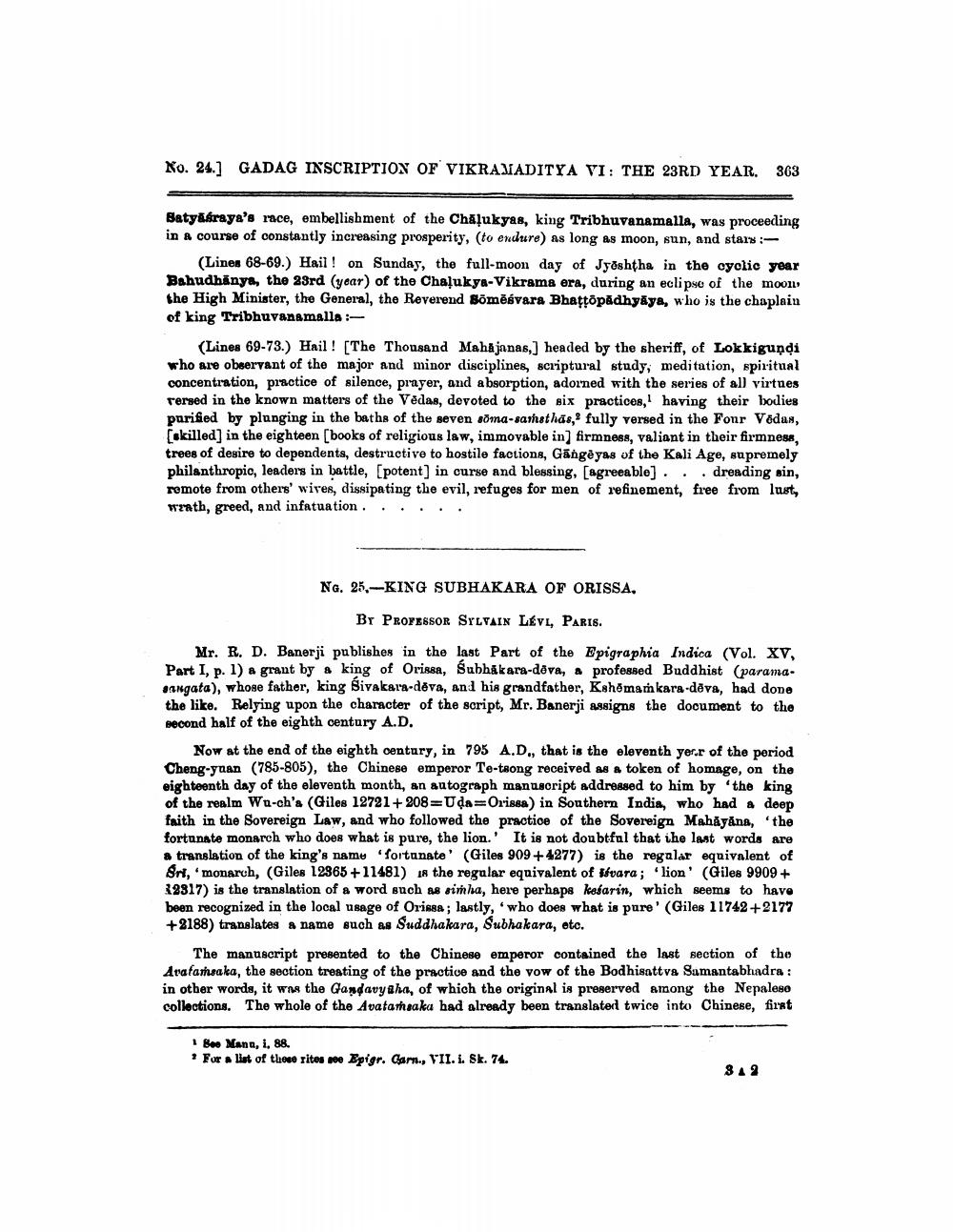________________
No. 24.] GADAG INSCRIPTION OF VIKRAMADITYA VI: THE 23RD YEAR. 363
Batyásraya's race, embellishment of the Chāļukyas, king Tribhuvanamalla, was proceeding in a course of constantly increasing prosperity, (to endure) as long as moon, sun, and stars :
(Lines 68-69.) Hail! on Sunday, the full-moon day of Jyoshtha in the cyclic year Bahudhänya, the 23rd (year) of the Chalukya-Vikrama era, during an eclipse of the moon the High Minister, the General, the Reverend Bömēsvara Bhattopadhyāya, who is the chaplain of king Tribhuvanamalla :
(Lines 69-73.) Hail ! [The Thousand Mahajanas,] headed by the sheriff, of Lokkigundi who are observant of the major and minor disciplines, scriptural study, meditation, spiritual concentration, practice of silence, prayer, and absorption, adorned with the series of all virtues rersed in the known matters of the Vedas, devoted to the six practices,' having their bodies purified by plunging in the baths of the seven soma-samsthās, fully versed in the Fonr Vödas, (skilled) in the eighteen [books of religious law, immovable in) firmness, valiant in their firmness, trees of desire to dependents, destructive to hostile factions, Gängeyas of the Kali Age, supremely philanthropic, leaders in battle, (potent) in curse and blessing, (agreeable] ... dreading sin, remote from others' wives, dissipating the evil, refuges for men of refinement, free from lust, weath, greed, and infatuation.....
NG. 25.--KING SUBHAKARA OF ORISSA.
BY PROFESSOR SILTAIN LÉVL, PARIS.
Mr. R. D. Banerji publishes in the last part of the Epigraphia Indica (Vol. XV, Part I, p. 1) a grant by & king of Orissa, Subhākara-dova, professed Buddhist (parama. gangata), whose father, king Sivakara-déva, and his grandfather, Kshomam kara-dova, had done the like. Relying upon the character of the script, Mr. Banerji Assigns the document to the second half of the eighth century A.D.
Now at the end of the eighth century, in 795 A.D., that is the eleventh yer.r of the period Cheng-yaan (785-805), the Chinese emperor Te-trong received as a token of homage, on the eighteenth day of the eleventh month, an autograph manuscript addressed to him by the king of the realm Wu-ch's (Giles 12721 +208=Uda=Orissa) in Southern India, who had a deep faith in the Sovereign Law, and who followed the practioe of the Sovereign Mahāyāna, "the fortunate monarch who does what is pure, the lion. It is not doubtful that ihe last words are a translation of the king's namu "fortanate' (Giles 909 +4277) is the regalar equivalent of Sri, monarch, (Giles 12965 +11481) in the regalar equivalent of Isvara ; lion' (Giles 9909 + 32317) is the translation of a word such as sinha, here perhaps kasarin, which seems to have been recognized in the local usage of Orissa; lastly, who does what is pure' (Giles 11742+2177 +2188) translates & name such as Suddhakara, Subhakara, etc.
The manuscript presented to the Chinese emperor contained the last section of the Aratamsaka, the section treating of the practice and the vow of the Bodhisattva Samantabhadra : in other words, it was the Gandavyaha, of which the original is preserved among the Nepalese collections. The whole of the Avatarsaka had already been translated twice into Chinese, first
Bee Mana, i, 88. . For list of those rites ne Epigr. Cam., VII. i. Sk. 74.
842




